The best way to understand Australian landscape art? Go feral in the remote wild
Of all the art events I’ve attended over the past decade, my trips to Newhaven have proven the most valuable.
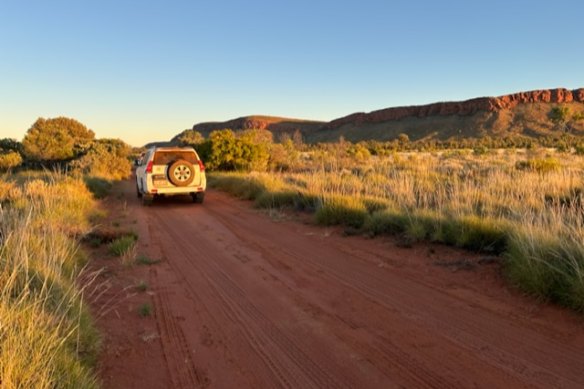
Down a dusty road at Newhaven, just outside the Great Sandy Desert.
Seven years ago, I spent a few days at Newhaven, a property on the edge of the Great Sandy Desert owned and administered by the Australian Wildlife Conservancy (AWC). Last week, I returned, in company with a group of artists who had seven days to make sketches and observations in preparation for an exhibition in one year’s time.
The show, which has the working title Six Ways of Looking at Newhaven, will be the culmination of a long-term project that began in 2012–13 and has seen 25 artists visit four remote properties around the country. Each visit leads to a selling exhibition in which the artists donate work to the value of $45,000.
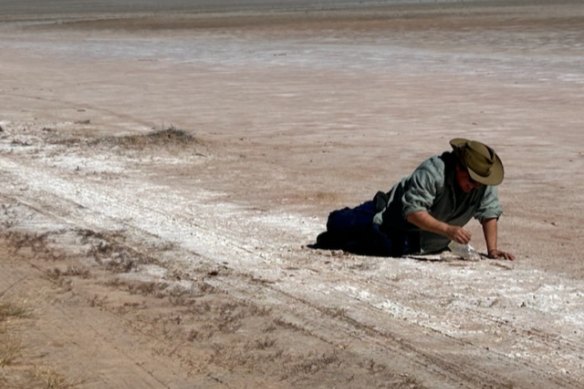
Sophie Cape, in the pose of The Dying Gladiator, collecting salt.
The initial aim has been to raise a million dollars for the AWC. For many of the artists, it has been the experience of a lifetime to explore a unique natural environment in company with scientists and ecologists. Each of the camps has been filmed, generating a series of documentaries. The plan is to turn all this material into a survey exhibition, a feature-length film and publication that can be sent around Australia and overseas, raising awareness of AWC activities and giving exposure to the artists involved.
I’ve been on board with the project since its inception and have written about each of the shows. This time, I thought it might be interesting to focus on the trip itself, which included six artists: Sophie Cape, Nicolette Eisdell, Pamela Honeyfield, Michelle Hungerford, Charmaine Pike and Ana Pollak, along with filmmakers Kathryn Milliss and Anna Howard.
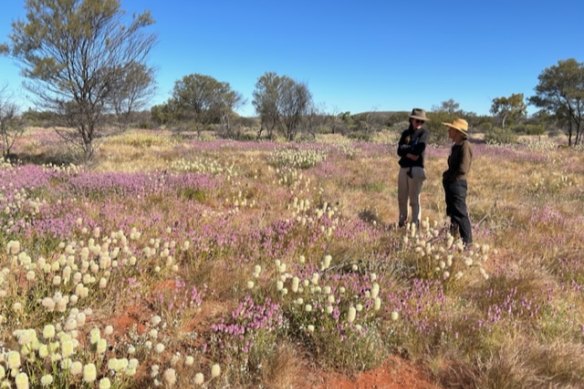
Field of wildflowers, with AWC officer, Jessica Holding and Ana Pollak.
Over the first three days, we were introduced to the property’s features, from fields of wildflowers to the rocky landscape of Potato Gorge to a brimming Lake Bennett, packed with waterbirds and insects after record rainfalls. In a helicopter, we traversed much of the 600,000 hectares of Newhaven and the adjoining Ngalurrtju Aboriginal Land Trust, making stops in gigantic salt pans and dunes in which the tops of trees emerge from mountains of soft red sand.
The heart of Newhaven consists of 9450 hectares of fenced-off land from which every feral predator has been removed. This is a serious matter because there are more than 3 million feral cats in Australia, each killing five animals per night. If we include those killed by foxes, the resulting number exceeds 2.6 billion small mammals, birds, and reptiles per year.
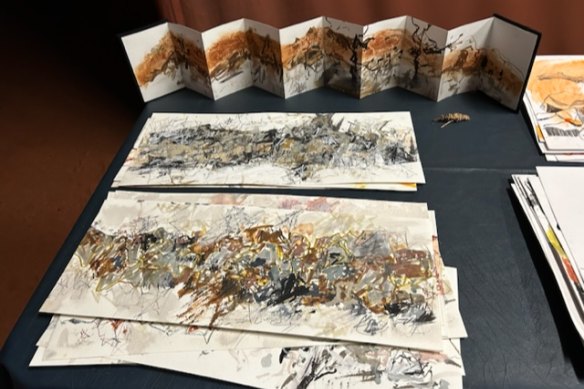
Pamela Honeyfield’s work on display, last night of camp.
These are the kind of statistics the AWC uses to convince private and corporate sponsors to fund an operation that has seen the group become the largest private conservation landowners in Australia, with 32 separate properties. The other winning argument is the extreme leanness and efficiency of the organisation, which is science-based, employs more than 70 per cent of its staff in the field, and spends 85 per cent of its income on conservation. Land management and data gathering goes on 365 days a year.
Visitors are taken on early morning visits to animal traps to see what creatures have been collected overnight. Afternoons are spent with the local Indigenous women who work as rangers and have become famous for their tracking skills. Christine Ellis and her colleagues have been known to track feral cats more than 30 kilometres before dispatching them. Last week, we walked with the ladies down a dusty road while they identified every animal or reptile that had passed that way. They can tell if there was a fight or a romantic encounter in the sand. They know if an eagle plucked an animal from the ground or a goanna chased a spider down a hole.

Down a dusty road at Newhaven, just outside the Great Sandy Desert.
On this stroll, they contented themselves with tracking down witchetty grubs and bush potatoes, finding one truly spectacular tuber, at least a metre in length. At Newhaven, the trackers have played a vital role in helping eradicate ferals so that endangered species such as the mala (aka the tiny rufous hare-wallaby), the burrowing bettong, the central rock rat and the golden bandicoot may be reintroduced, and their numbers allowed to expand.
The problem for the artists was how these experiences should feed into their work. During the first three days, one absorbs information and visual stimuli. In the following days, it’s a matter of making sense of these discoveries and searching for a way to translate them into paintings and drawings.
All participants found it rewarding to spend time with other artists, most of them strangers before this trip. They were uniformly impressed with the knowledge and dedication of the young field officers and staggered by the landscapes we encountered. On the other hand, there is immense pressure to process these new experiences in those few short days spent working in the field. It wasn’t until the last night of camp, when the artists were invited to make a show from their work-in-progress that every painter could see what the others were doing and feel reassured that the trip would be a success.
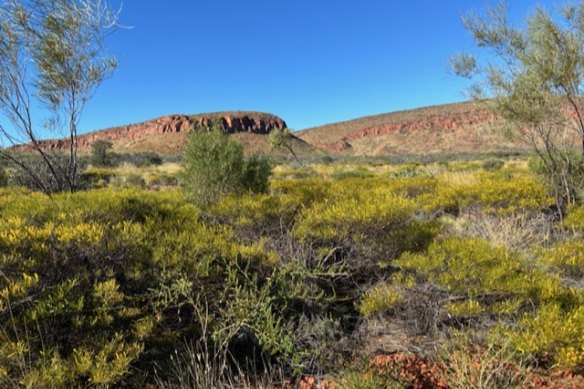
View from John McDonald’s tent, Newhaven
To take only one motif – the desert oaks that grew around the campsite – it was remarkable to see how different artists drew and painted these unique, spindly trees. The massed ferrous rocks at Potato Gorge offered another study in contrasts, with one artist depicting masses of hard-edged, compacted forms, another painting them in a more lyrical fashion.
A field of wildflowers might be laid in with hundreds of tiny flicks of the brush on bare paper or captured in a moody, atmospheric picture that feels almost claustrophobic. Sophie Cape attempted to work on a larger scale, painting a schematic landscape with found materials such as ash, charcoal and ochre on the back of a vinyl tablecloth. Nicolette Eisdell, better known as a portraitist, made expressive drawings of dead wallaroo, found seated in a rock crevice like an ancient mummy.
In a year’s time, the best of these preliminary gouaches and sketches will have been discarded or worked up into large-scale paintings. Yet, it’s important the final exhibition also includes pieces made at the Newhaven sanctuary en plein air which capture the artists’ spontaneous responses to a desert environment enlivened by recent rainfall.
It may sound overly romantic to talk of essences, but there is something quintessentially Australian in the experience of the desert, which makes up roughly 70 per cent of this country’s land mass. It is the great mythical unconscious that underpins our fluctuating sense of identity – that ancient environment once seen as harsh and barren, which now seems full of life. It’s partly to do with our enhanced understanding of the Aboriginal relationship to the land, and partly due to the efforts of scientists, naturalists and conservationists who have broken down those barriers of fear and indifference that once dominated our views of the outback.
Of all the art events I’ve attended over the past decade, these AWC field trips have been the most valuable in terms of expanding horizons of thought and feeling. To truly understand the hold that landscape painting has always exerted on Australian art, there’s no better method than to go feral for a week in a remote part of the continent and soak up some vital energy.
Six Ways of Looking at Newhaven is an exhibition in the making. John McDonald was a guest of the Australian Wildlife Conservancy.